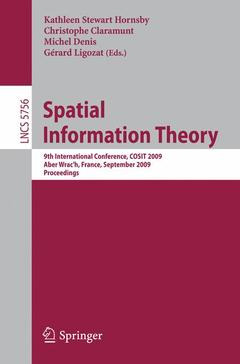Spatial Information Theory, 2009 9th International Conference, COSIT 2009, Aber Wrac'h, France, September 21-25, 2009, Proceedings Theoretical Computer Science and General Issues Series
Langue : Anglais
Coordonnateurs : Stewart Hornsby Kathleen, Claramunt Christophe, Denis Michel, Ligozat Gérard

First established in 1993 with a conference in Elba, Italy, COSIT (the International C- ference on Spatial Information Theory) is widely acknowledged as one of the most - portant conferences for the field of spatial information theory. This conference series brings together researchers from a wide range of disciplines for intensive scientific - changes centered on spatial information theory. COSIT submissions typically address research questions drawn from cognitive, perceptual, and environmental psychology, geography, spatial information science, computer science, artificial intelligence, cog- tive science, engineering, cognitive anthropology, linguistics, ontology, architecture, planning, and environmental design. Some of the topical areas include, for example, the cognitive structure of spatial knowledge; events and processes in geographic space; incomplete or imprecise spatial knowledge; languages of spatial relations; navigation by organisms and robots; ontology of space; communication of spatial information; and the social and cultural organization of space to name a few. This volume contains the papers presented at the 9th International Conference on Spatial Information Theory, COSIT 2009, held in Aber Wrac?h, France, September 21?25, 2009. For COSIT 2009, 70 full paper submissions were received. These papers were carefully reviewed by an international Program Committee based on relevance to the conference, intellectual quality, scientific significance, novelty, relation to previously published literature, and clarity of presentation. After reviewing was completed, 30 papers were selected for presentation at the conference and appear in this volume. This number of papers reflects the high quality of submissions to COSIT this year.
Cognitive Processing and Models for Spatial Cognition.- A Conceptual Model of the Cognitive Processing of Environmental Distance Information.- Spatial Cognition of Geometric Figures in the Context of Proportional Analogies.- Are Places Concepts? Familarity and Expertise Effects in Neighborhood Cognition.- Semantic Modeling.- A Metric Conceptual Space Algebra.- Grounding Geographic Categories in the Meaningful Environment.- Terabytes of Tobler: Evaluating the First Law in a Massive, Domain-Neutral Representation of World Knowledge.- Spatial Reasoning.- Merging Qualitative Constraint Networks Defined on Different Qualitative Formalisms.- Semi-automated Derivation of Conceptual Neighborhood Graphs of Topological Relations.- Exploiting Qualitative Spatial Constraints for Multi-hypothesis Topological Map Learning.- Comparing Relations with a Multi-holed Region.- Spatial Cognition.- The Endpoint Hypothesis: A Topological-Cognitive Assessment of Geographic Scale Movement Patterns.- Evaluating the Effectiveness and Efficiency of Visual Variables for Geographic Information Visualization.- SeaTouch: A Haptic and Auditory Maritime Environment for Non Visual Cognitive Mapping of Blind Sailors.- Spatial Knowledge.- Assigning Footprints to Dot Sets: An Analytical Survey.- Mental Tectonics - Rendering Consistent ?Maps.- To Be and Not To Be: 3-Valued Relations on Graphs.- Map Algebraic Characterization of Self-adapting Neighborhoods.- Scene and Visibility Modeling.- Scene Modelling and Classification Using Learned Spatial Relations.- A Qualitative Approach to Localization and Navigation Based on Visibility Information.- Showing Where To Go by Maps or Pictures: An Empirical Case Study at Subway Exits.- Spatial Modeling.- The Abduction of Geographic Information Science: Transporting Spatial Reasoning to the Realm of Purpose and Design.- An Algebraic Approach to Image Schemas for Geographic Space.- Spatio-terminological Inference for the Design of Ambient Environments.- Events and Processes.- Defining Spatial Entropy from Multivariate Distributions of Co-occurrences.- Case-Based Reasoning for Eliciting the Evolution of Geospatial Objects.- Composing Models of Geographic Physical Processes.- Route Planning.- Decentralized Time Geography for Ad-Hoc Collaborative Planning.- Adaptable Path Planning in Regionalized Environments.- An Analysis of Direction and Motion Concepts in Verbal Descriptions of Route Choices.- The Role of Angularity in Route Choice.
Date de parution : 09-2009
Ouvrage de 505 p.
15.5x23.5 cm
Thèmes de Spatial Information Theory :
© 2024 LAVOISIER S.A.S.



